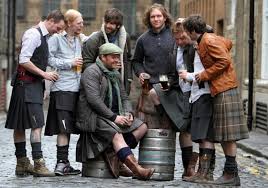Introduction:
In the world of kilts, where tradition meets innovation, one garment stands out for its rugged elegance and timeless appeal: the leather kilt. Crafted from high-quality leather and inspired by both Scottish heritage and contemporary fashion, the leather kilt embodies strength, style, and sophistication. Join us as we delve into the history, definition, and diverse uses of this iconic piece of attire.
History:
The history of leather kilts dates back centuries, with leather being a staple material in clothing and armor across cultures and civilizations. In Scotland, leather garments were traditionally worn by warriors and hunters for their durability and protection in harsh environments. Over time, leather kilts evolved from practical attire to fashionable statement pieces, reflecting the changing tastes and lifestyles of wearers.
During the Victorian era, leather kilts experienced a resurgence in popularity as part of the Highland revival movement, which sought to celebrate and preserve Scottish culture and traditions. Inspired by the romanticized imagery of Scottish warriors and the rugged landscapes of the Highlands, leather kilts became a symbol of strength, resilience, and masculine elegance.
Definition:
The leather kilt is a modern variation of the traditional Scottish kilt, crafted from high-quality leather and featuring the signature pleated design and waistband of its Scottish counterpart. Available in a range of styles and finishes, leather kilts may feature intricate detailing, such as embossed patterns, studs, and buckles, adding a touch of luxury and individuality to the garment.
Uses:
- Fashion and Lifestyle: The leather kilt has transcended its origins as practical attire and has become a fashion statement for individuals seeking a bold and distinctive look. Whether worn as part of a casual ensemble or paired with formal attire for special occasions, the leather kilt exudes a sense of confidence, style, and sophistication.
- Biker Culture: Leather kilts have long been embraced by motorcycle enthusiasts and members of the biker community for their association with rebellion, freedom, and rugged masculinity. Worn with leather jackets and boots, the leather kilt adds an edgy flair to biker attire, reflecting the adventurous spirit and camaraderie of the open road.
- Festivals and Events: Leather kilts are a common sight at cultural festivals, music concerts, and Renaissance fairs, where participants embrace alternative fashion and eclectic styles. Their distinctive appearance and rugged charm make them a favorite among attendees looking to make a statement while celebrating their heritage or personal style.
- Formal Wear: In recent years, leather kilts have gained popularity as formal attire for weddings, parties, and other special events. Paired with a crisp shirt, vest, and accessories, the leather kilt offers a unique and sophisticated alternative to traditional formalwear, adding a touch of elegance and individuality to any occasion.
Conclusion:
The leather kilt embodies the timeless fusion of style and strength, blending the rich heritage of Scottish craftsmanship with the durability and versatility of leather. From its origins as practical attire for warriors and hunters to its current status as a fashionable statement piece, the leather kilt continues to captivate wearers with its rugged elegance and timeless appeal.
Whether worn for fashion, function, or personal expression, the leather kilt remains a symbol of confidence, individuality, and masculine sophistication. As we celebrate its rich history and embrace its modern allure, let us appreciate the leather kilt for its ability to unite tradition with contemporary style, honoring both the past and the present in a single garment.

